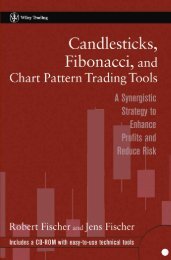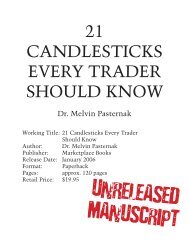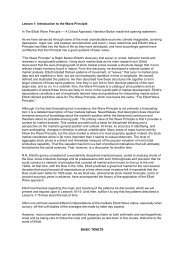The Ultimate Technical Analysis Handbook - Tradingportalen.com
The Ultimate Technical Analysis Handbook - Tradingportalen.com
The Ultimate Technical Analysis Handbook - Tradingportalen.com
You also want an ePaper? Increase the reach of your titles
YUMPU automatically turns print PDFs into web optimized ePapers that Google loves.
Chapter 2 — How To Confirm You Have the Right Wave Count<br />
<strong>The</strong> Wave Principle describes 13 wave patterns – not to mention the additional patterns they make when<br />
<strong>com</strong>bined. With so many wave patterns to choose from, how do you know if you are working the right wave<br />
count? Usually, the previous wave in a developing pattern gives the Elliott wave practitioner an outline of<br />
what to expect (i.e., wave 4 follows wave 3, and wave C follows wave B). But only after the fact do we know<br />
with <strong>com</strong>plete confidence which kind of wave pattern has just unfolded. So as patterns are developing, we are<br />
faced with questions like these: It looks like a five-wave advance, but is it wave A, 1 or 3? Here’s a three-wave<br />
move, but is it wave A, B or X?<br />
How can we tell the difference between a correct and an incorrect labeling? <strong>The</strong> obvious answer is that prices<br />
will move in the direction you expect them to. However, the more useful answer to this question, I believe,<br />
is that prices will move in the manner they are supposed to. For example, within a five-wave move, if wave<br />
three doesn’t travel the farthest in the shortest amount of time, then odds are that the labeling is incorrect. Yes,<br />
I know that sometimes first waves extend and so do fifth waves (especially in <strong>com</strong>modities), but most typically,<br />
prices in third waves travel the farthest in the shortest amount of time. In other words, the personality of price<br />
action will confirm your wave count.<br />
Each Elliott wave has a distinct personality that supports its labeling. As an example, second waves are most<br />
often deep and typically end on low volume. So if you have a situation where prices have retraced a .382<br />
multiple of the previous move and volume is high, odds favor the correct labeling as wave B of an A-B-C<br />
correction and not wave 2 of a 1-2-3 impulse. Why? Because what you believe to be wave 2 doesn’t have the<br />
personality of a corrective wave 2.<br />
Prechter and Frost’s Elliott Wave Principle describes the personality of each Elliott wave (see EWP, pp. 78-84).<br />
But here’s a shortcut for starters: Before you memorize the personality of each Elliott wave, learn the overall<br />
personalities of impulse and corrective waves:<br />
• Impulse waves always subdivide into five distinct waves, and they have an energetic personality that<br />
likes to cover a lot of ground in a short time. That means that prices travel far in a short period, and<br />
that the angle or slope of an impulse wave is steep.<br />
• Corrective waves have a sluggish personality,<br />
the opposite of impulse waves. <strong>The</strong>y<br />
are slow-moving affairs that seemingly<br />
take days and weeks to end. During that<br />
time, price tends not to change much. Also,<br />
corrective wave patterns tend to contain<br />
numerous overlapping waves, which appear<br />
as choppy or sloppy price action.<br />
To apply this “wave personality” approach in real<br />
time, let’s look at two daily price charts for Wheat,<br />
reprinted from the August and September 2005 issues<br />
of Monthly Futures Junctures.<br />
Figure 4 from August shows that I was extremely<br />
bearish on Wheat at that time, expecting a massive<br />
selloff in wave three-of-three. Yet during the first<br />
Figure 4<br />
<strong>The</strong> <strong>Ultimate</strong> <strong>Technical</strong> <strong>Analysis</strong> <strong>Handbook</strong> — © 2009 Elliott Wave International<br />
This ebook includes handpicked lessons from more than 200 pages of EWI’s <strong>com</strong>prehensive<br />
Trader’s Classroom Collection of eBooks. Learn more here: http://www.elliottwave.<strong>com</strong>/wave/ClubTCC<br />
6





